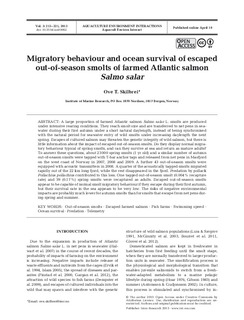| dc.contributor.author | Skilbrei, Ove | |
| dc.date.accessioned | 2013-08-19T09:24:41Z | |
| dc.date.available | 2013-08-19T09:24:41Z | |
| dc.date.issued | 2013-04-10 | |
| dc.identifier.citation | Skilbrei OT (2013) Migratory behaviour and ocean survival of escaped out-of-season smolts of farmed Atlantic salmon Salmo salar. Aquacult Environ Interact 3:213-221 | no_NO |
| dc.identifier.issn | 1869-7534 | |
| dc.identifier.issn | 1869-215X | |
| dc.identifier.uri | http://hdl.handle.net/11250/109183 | |
| dc.description.abstract | A large proportion of farmed Atlantic salmon Salmo salar L. smolts are produced under intensive rearing conditions. They reach smolt size and are transferred to net pens in seawater during their first autumn under a short natural daylength, instead of being synchronised with the natural period for seawater entry of wild smolts under increasing daylength the next spring. Escapes of cultured salmon may threaten the genetic integrity of wild salmon, but there is little information about the impact of escaped out-of-season smolts. Do they display normal migratory behaviour typical of spring smolts, and can they survive at sea and return as mature adults? To answer these questions, about 23000 spring smolts (1 yr old) and a similar number of autumn out-of-season smolts were tagged with T-bar anchor tags and released from net pens in Masfjord on the west coast of Norway in 2007, 2008 and 2009. A further 43 out-of-season smolts were equipped with acoustic transmitters in 2008. A quarter of the acoustically tagged smolts migrated rapidly out of the 22 km long fjord, while the rest disappeared in the fjord. Predation by pollack Pollachius pollachius contributed to this loss. One tagged out-of-season smolt (0.004% recapture rate) and 39 (0.17%) spring smolts were recaptured as adults. Escaped out-of-season smolts appear to be capable of normal smolt migratory behaviour if they escape during their first autumn, but their survival rate in the sea appears to be very low. The risks of negative environmental impacts are probably much lower for autumn smolts than for smolts that escape from net pens during spring and summer. | no_NO |
| dc.language.iso | eng | no_NO |
| dc.publisher | Inter-Research | no_NO |
| dc.title | Migratory behaviour and ocean survival of escaped out-of-season smolts of farmed Atlantic salmon Salmo salar | no_NO |
| dc.type | Journal article | no_NO |
| dc.type | Peer reviewed | no_NO |
| dc.subject.nsi | VDP::Agriculture and fishery disciplines: 900::Fisheries science: 920::Aquaculture: 922 | no_NO |
| dc.source.pagenumber | 213-221 | no_NO |
| dc.source.volume | 3 | no_NO |
| dc.source.journal | Aquaculture Environment Interactions | no_NO |
| dc.source.issue | 3 | no_NO |
| dc.identifier.doi | 10.3354/aei00062 | |
